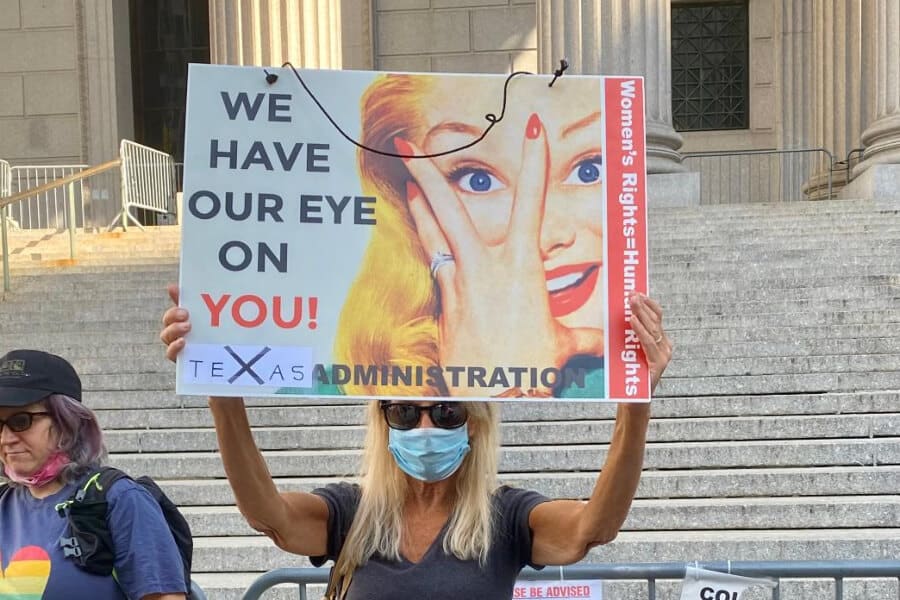Step on women’s rights and they start marching. If you stomp on justice they will take to the streets. They march against misogynist presidents and protest economic inequality. And over and over again they have marched countless miles for reproductive rights, and it hasn’t stopped.
I’ve tracked more than a few miles myself. I’ve been marching for the right to choose for nearly 40 years. I’m weary. I’m menopausal. But as the Supreme Court seems poised to overturn Roe V. Wade I have no choice. Because for a woman there has to be choice when it comes to her own body.
Four decades of marching has not been enough.
I never thought in 2022 I’d be back out demonstrating for a woman’s right to choose her constitutional guarantee for a safe and legal abortion. I had hoped we had closed that chapter. Yet this Saturday I will join with millions of other women across the country in “Bans Off Our Bodies” yet another march to protect reproductive rights and demonstrate against anti-choice leaders whose ultimate goal is outlawing abortion.
The double gut punch of the leaked documents and the Senate Republicans blocking Federal legislation to protect abortion access potentially altering the lives of an entire generation of young women made me gasp at the cruelty.
Four decades of marching was not enough. After thirty-six years of solidarity with other women protesting, the health of Roe is now on life support.
Read More: Bounty Hunters & Backrooms: Texas Anti-Abortion Laws Bring Back This 1965 Nightmare
The First March
I had naively assumed my first pro-choice march in the spring of 1986 would be my last for this cause. That somehow this earnest demonstration would make a difference and the fate of Roe v. Wade would be secured once and for all.
My own abortion three years earlier was still a fresh memory.
This was an issue that spoke deeply to me. My own abortion three years earlier was still a fresh memory. It was in fact never far from my thoughts. As I sunk into the soft coach seat of the Amtrak train, it played out in my mind in an endless loop as I rode from NYC to Washington D.C. to participate in the March for Women’s Lives. My abortion had been a difficult choice but one I was grateful to have.
This march organized by NOW was held in reaction to the annual Right to Life protests. That January it had drawn a crowd of 40,000 anti-abortion demonstrators who marched to the Capitol. The religious right had the ear of the Reagan White House, and like so many I feared that those bent on repealing Roe v. Wade had convinced the President, Congress, and the media that a majority of Americans opposed abortion.
I knew I needed to be counted.
Making History
Looking out at the sea of young women my age that had gathered on the grassy Mall between the Washington Monument and the Capitol was inspiring.
More than 80,000 demonstrators had come to Washington D.C. to support Roe v. Wade. At a time before social media the numbers are staggering. The March for Women’s Lives was described at the time as the biggest feminist rally ever.
It was history. We would be making history, maybe closing a chapter on questioning women’s reproductive rights.
Not the church, not the state, women must decide their fate.
Marching in solidarity under cloudless skies in unseasonably warm weather, there was a festive air. Elbow to elbow, I was enveloped by women from across the country.
We filled the length 15 abreast along Pennsylvania Avenue between the White House and Capitol for much of the afternoon. Little did I realize that this three-mile route would become all too familiar.
Waving my homemade “Pro-Choice is Pro-Life” sign along with other the marchers who carried banners demanding lawmakers to “Stay Out of My Uterus,” we chanted loudly in unison: “Not the church, not the state, women must decide their fate.”
It was these chanting’s and later the roar of the crowd boisterously repeating “Bella, Bella” as former Congresswoman Bella Abzug began speaking at the rally, that became the soundtrack for the day, filling my mind with exhilaration and hope as I rode the train back to New York later that evening.
The Next March
Six years later I was back in D.C. marching past monuments and April’s cherry blossoms for the very same cause. This march came at a time of heightened urgency for the abortion rights movement with a sense that Roe v.Wade was in mortal danger.
In a few weeks, the Supreme Court was set to hear arguments in a Pennsylvania law that sought to limit access to abortion through a variety of regulations including a 24-hour waiting period and a requirement that women seeking abortions notify their husbands. Many saw the case as a vehicle to overturn Roe v. Wade.
As the 1992 presidential election approached abortion was a divisive and emotional political issue.
We thronged the Capitol not only to protest such reproductive restrictions but to also assert the growing political power of women.
The crowds to protest had grown. At least half a million advocates streamed down Washington streets for a march and rally to support abortion rights. Marchers came from all over the nation by plane, train, bus, and car. I was surrounded by mothers and daughters, teachers and doctors, husbands and brothers. Hollywood stars marched side by side with Republican’s For Choice and Catholics for Choice.
The Democratic presidential candidates took part in the march taking a break from campaigning. Governor Bill Clinton’s supporters chanted “Pro-choice, Pro Clinton” along with a flurry of campaign signs, while Jerry Brown’s team handed out literature, which I happily collected.
We thronged the Capitol not only to protest such reproductive restrictions but to also assert the growing political power of women in a year of Presidential and Congressional elections.
Like many of the marchers, I wore suffragette white, and carried a new handmade sign, “We Won’t Go Back.” Passing the White House, I roared at the top of my lungs in unison, “We’re feminists, we’re fierce and we vote!” Others tossed tennis balls on the White House lawn with the message, “Are you ready to be a Mother?”
The anti-abortion groups were out in full force holding aloft signs of aborted fetuses along the parade route. Their shouts of “shame” tried to drown us out, but they were way outnumbered. Shame on them.
It was called one of the largest protest marches in history.
Marching…Again
In April 2004 a massive collective call was put out to restore and preserve women’s health and reproductive rights. Again.
This time a million people converged on Washington to sound the alarm at President George Bush’s administration’s attempts to chip away at women’s reproductive rights both domestically and globally.
I was among them.
There had been an intensifying attack on abortion rights since 2002 when an anti-choice White House and Congress began using legislation, and judicial appointments to roll back the clock on abortion rights.
That time bomb was ticking again.
Unlike the 1986 march organized by just one group and focused exclusively on the rights of U.S. women, this March for Women’s Lives was led by several activist groups addressing health and reproductive issues on a global scale. This was an opportunity to express solidarity among women both in the United States and globally, a chance to say “No more!” to American policies that hurt women here and abroad.
Once again it easily broke attendance records for national reproductive-rights rallies.
We are not going backwards child, never again.
Under an overcast sky, a sea of faces stretched more than a mile, from one end of the national mall to the other for a late afternoon four-hour rally after the march. Filled with women, men, children, and even babies wearing the bright pink T-shirts of Planned Parenthood, we listened to a diverse group of lawmakers and feminists including Senator Hillary Clinton, Nancy Pelosi, Madeline Albright, and Gloria Steinem.
But it was Whoopi Goldberg I remember the most.
Waving a white coat hanger, the comedian kicked off the afternoon rally with a vow to never to return to the days of back-alley abortions that prevailed before the Supreme Court legalized abortion in 1973.
“This was the choice,” Goldberg said as she held up the hanger. “This was it. And I’m here to tell you, never again. We are not going backwards child, never again.”
A million voices rose, full of hope that this would be the wake-up call. We would never go back.
Tomorrow Morning
This Saturday I will do it again at the “Bans Off NYC” march.
Now at 67, four decades after my first Pro-Choice march, I am still protesting. Instead of protesting in front of the White House and the Capitol, I will rally in front of the courthouses in Foley Square in N.Y.C.
Closer to home, it is still a topic close to my heart.
My own abortion decades ago is still ever-present in my thoughts as it was 36 years ago. Conversations with friends revealed it was something we all had in common. A right we wanted to make sure this generation can avail themselves to if needed. If not, we are headed back to the dark ages, the dark ages of dark alleys, and illegal unsafe abortion.
When you tread on women’s liberties we don’t stand still. Even if we are getting weary of the fight.
Read More: 40 Years Later, I Still Have Conflicting Emotions About My Abortion
Top photo: The author at a march in New York City in fall 2021, when the Texas Abortion Law seemed like the biggest threat to reproductive rights. Photo by Tina Perlmutter.





















0 Comments